A super easy meal with sashimi quality tuna is one of my favourites. Maguro no Zuke-don (Marinated Tuna on Rice) requires no cooking. Just marinate tuna slices and place them on the cooked rice, topped with garnish. I always wonder how such a simple dish could be so tasty. If you add a salad and a miso soup, you’ll have a perfect meal in no time.
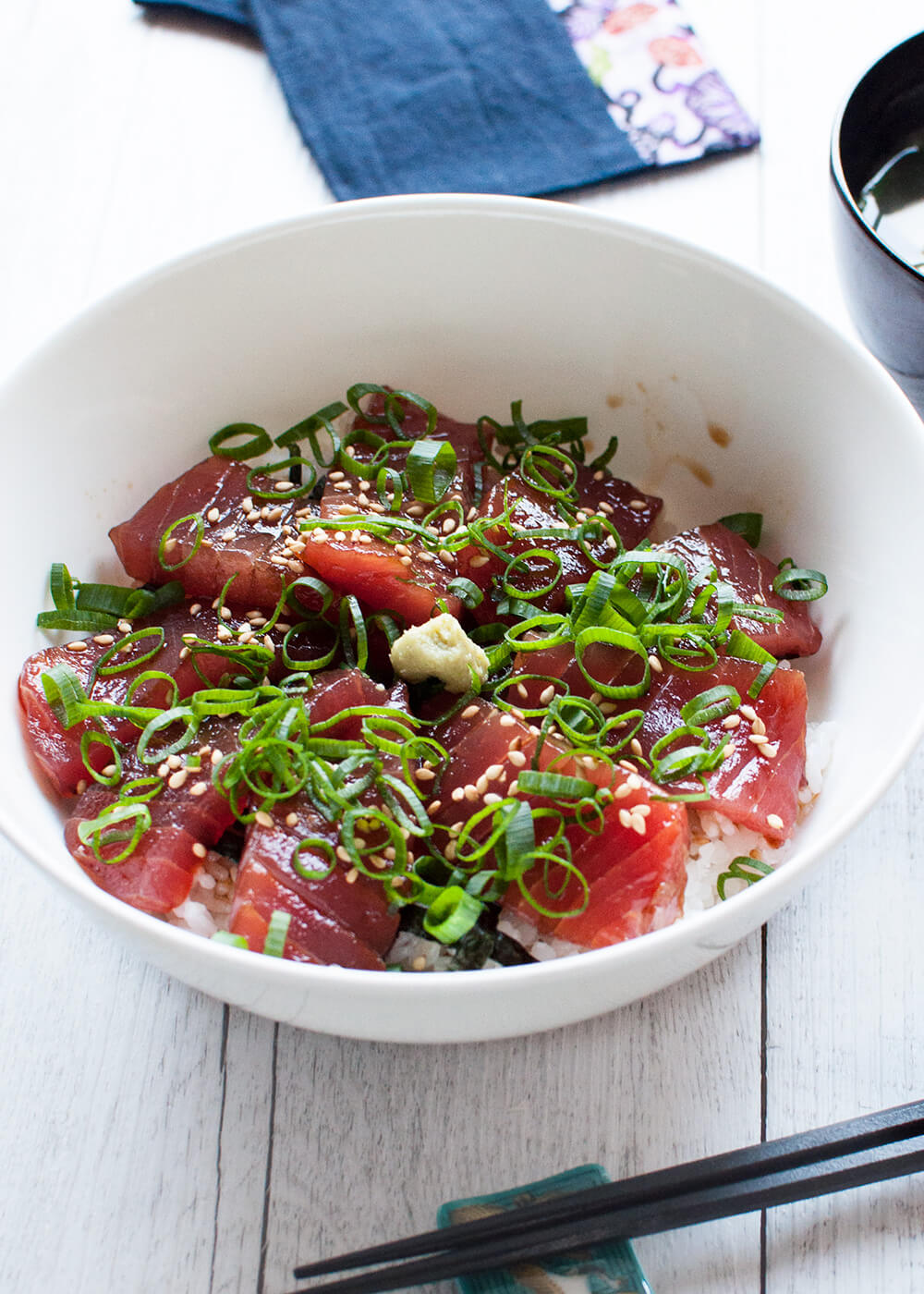
I love sashimi of any kind. I like the flavour of fresh raw fish but I also like the fact that it is so easy to prepare without needing to cook at all. High in protein, low in fat, what else can you ask for? I could eat sashimi every day, even for breakfast. When I go shopping and I am wondering what to eat for dinner, I often end up buying a small amount of sashimi.
If I was in Japan, perhaps I could eat different sashimi fish every day, but here in Sydney the varieties are limited. Most local fish shops sell only tuna and salmon sashimi, or sometimes kingfish. Only a few fish shops and the Sydney Fish Market sell other kinds of sashimi quality fish such as snapper, deep sea bream and trevally.
When I feel that I have been eating tuna or salmon sashimi repeatedly, I sometimes put a twist on the tuna sashimi and make maguro no zuke-don (マグロの漬け丼). Maguro (マグロ) means tuna and zuke-don (漬け丼) means marinades on rice in a bowl. The word “no” (の) is a particle to connect maguro and zuke-don.
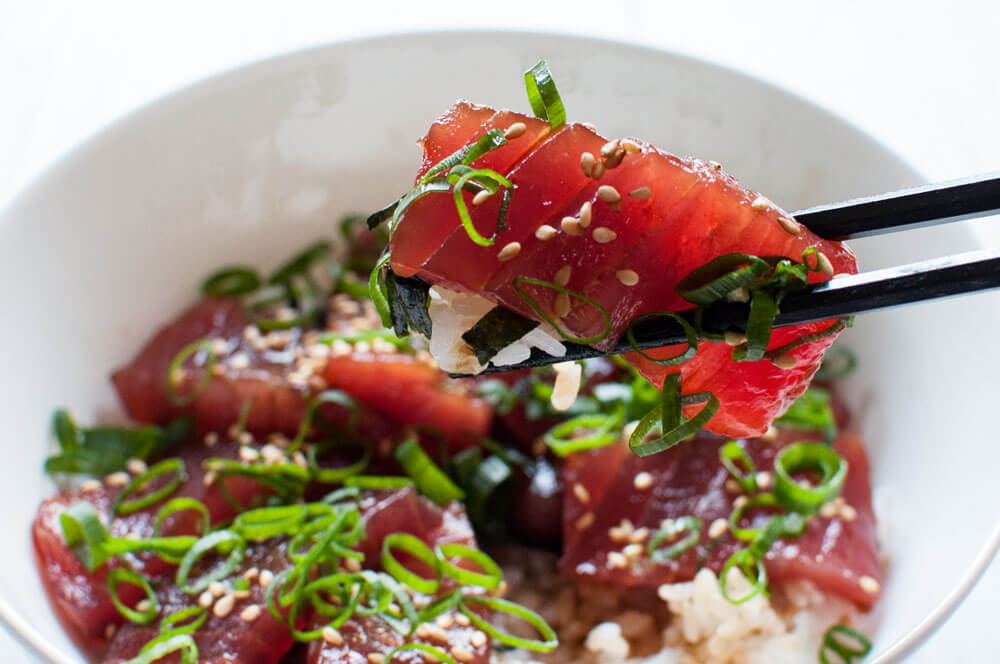
When I posted the recipe Oyako-don (chicken and Egg on Rice), I talked about ‘don’ (丼) and mentioned ‘tekka-don’ (鉄火丼, tuna sashimi on rice) as an example. Tekka-don is also tuna on rice in a bowl, but there are differences.
Tekka-don uses raw sashimi tuna slices without marinating them and the rice is vinegar flavoured (= sushi rice), while zuke-don uses marinated sashimi slices that are placed on normal rice. You will need a small plate of soy sauce to dip the sashimi in when eating tekka-don but zuke-don does not require a dipping sauce.
Some people do not distinguish between these names and call maguro no zuke-don “tekka-don”. But strictly speaking, that is not correct.
Today, I saw a block of sashimi tuna at my favourite fish shop. The tuna was really fresh and had beautiful red meat (see the top left photo below), which reminded me of tekka-don. The name “tekka” (鉄火) comes from the colour of a hot iron and the tuna at the fish shop was so red that I couldn’t think of any other word. But I only had normal rice so I decided to make marinated tuna on rice instead.
Zuke-don marinade is a mixture of soy sauce, sake and mirin. The ratio I used is 3:2:1 respectively which is easy to remember. I sometimes add a few drops of sesame oil to it. Marinate the sliced sashimi tuna for a minimum of 10-15 minutes but no more than 30 minutes. If you marinate sashimi slices for too long, the sashimi absorbs too much marinade and the flavour of the sashimi becomes too salty.
Place rice in a bowl, pour the marinade over the rice, spread yakinori (roasted seaweed) strips, spread marinated tuna slices, sprinkle with chopped shallots (scallions) and white sesame seeds. And maguro no zuke-don is done. So fast!
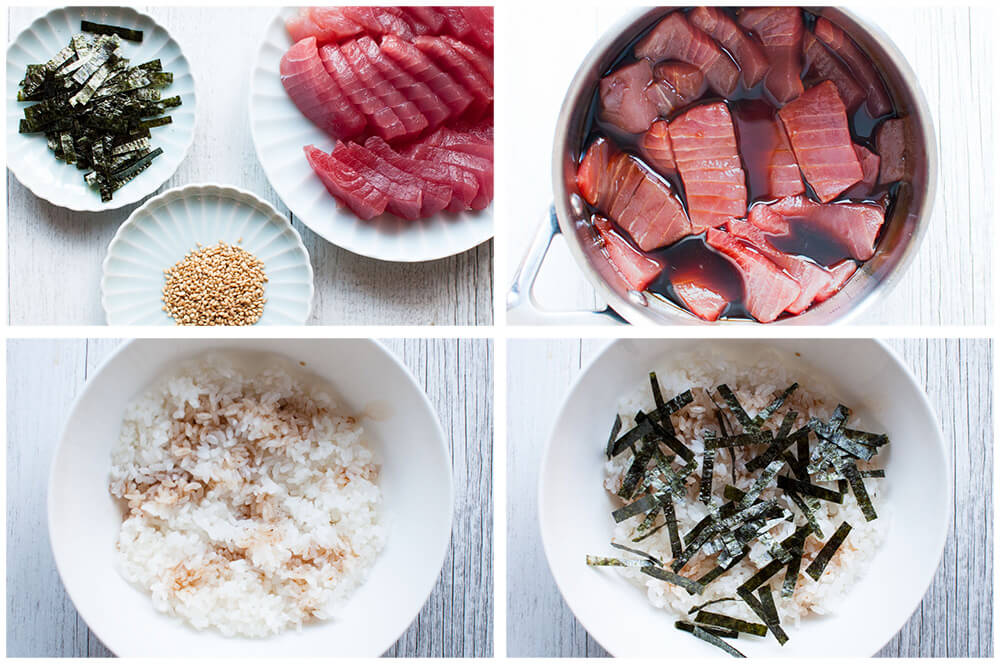
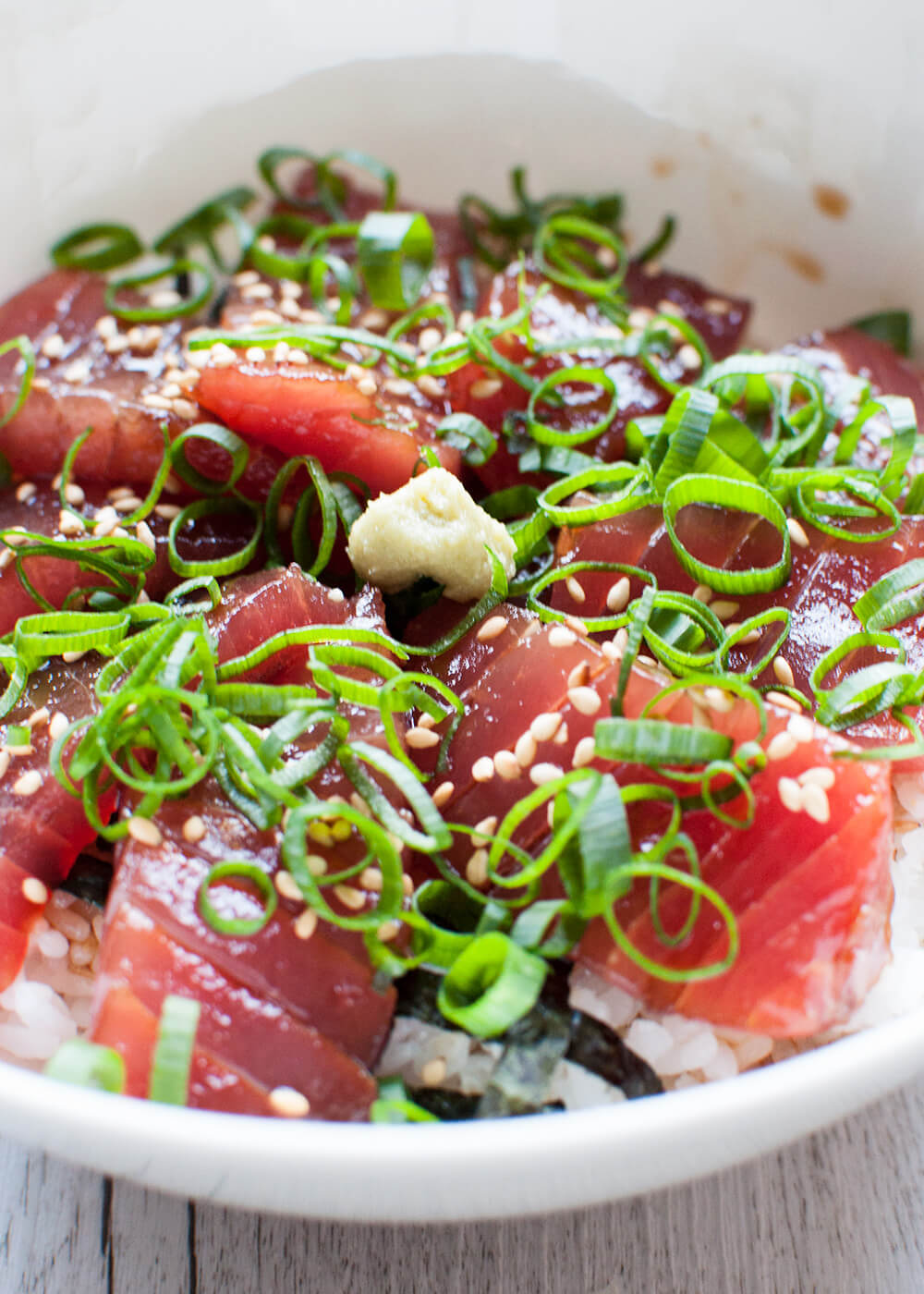
When I gave this zuke-don to my son, he was surprised to see the yakinori underneath the tuna. He thought the yakinori would be on top of tuna like other toppings. It is common to place yakinori on top of tuna in the case of tekka-don but with zuke-don, you usually place yakinori between the rice and tuna slices. It is up to you, though, whether yakinori goes before or after tuna.
Instead of tuna, you could use salmon, bonito, kingfish, etc if you like. If you marinate kingfish sashimi for example, then it will be called “buri no zuke-don” (ブリの漬け丼) as kingfish is “buri” in Japanese.
You must buy sashimi quality fish, though. When I make zuke-don with bonito or kingfish, I might add a small amount of grated ginger to the marinade so that the slight fishiness can be eliminated.
It is so simple to make that I cannot write about the dish any more today. If you like sashimi, I strongly recommend making maguro no zuke-don.
Yumiko![]()
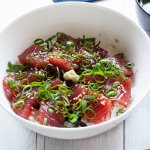
A super easy meal with sashimi quality tuna is one of my favourites. No cooking is required. Just marinate tuna slices and place them on the cooked rice, topped with garnish. I always wonder how such a simple dish can be so tasty. If you add a salad and a miso soup, you have a perfect meal in no time.
Prep Time includes 15 minutes of marinating time. So, the actual time you spend on this dish is about 10 minutes.
- 300 g (10.6oz) sashimi tuna (note 1)
- 2 bowls of cooked rice, about one cup of rice each (note 2)
- ½ sheet of yakinori (roasted seaweed), cut into 3cm (1¼") long thin strips
- 1 tsp white sesame seeds
- 2 tbsp shallots (scallions) finely chopped
- Wasabi (Japanese horseradish, optional)
-
If sashimi tuna is not sliced, slice it to 7mm (¼") thick. You can find how to slice sashimi in my post, Sashimi (Sliced Raw Fish).
-
Add sake and mirin to a pot and bring it to a boil. Boil for 10 seconds or so to let the alcohol evaporate.
-
Turn the heat off, add soy sauce and let the marinade cool down to room temperature. Add a few drops of sesame oil if using.
-
Add sliced tuna to the pot and marinate for about 10-15 minutes.
-
Take a tablespoon of marinade and scatter over the rice in a bowl.
-
Scatter half of the yakinori strips over the rice in a bowl, then cover the surface of the rice and yakinori with half of the marinated tuna pieces (note 3).
-
Sprinkle half of sesame seeds and shallots over the tuna with a small amount of wasabi paste in the centre if using.
-
Repeat steps 5 – 7 for the second bowl.
-
Serve immediately.
1. Instead of tuna, you could use salmon, kingfish, bonito, deep sea bream, trevally, etc. But you do have to purchase a sashimi quality fish.
2. A standard Japanese-style rice bowl would be too small as the tuna slices are placed on top of the rice. You could use a soup bowl or noodle soup bowl instead.
The rice can be hot or room temperature.
3. Instead of placing yakinori below the tuna slices, you can place the tuna first, then scatter yakinori, if you like.
Hi Yumiko!
I’m so excited that I found your website! I adore Japanese food, but because I have celiac I have to eat gluten-free (I’ve been GF for over 20 years). This makes it very difficult to have variety when I eat out at Japanese restaurants because as you know, the majority of Japanese dishes contain soy sauce. So when I eat out, I am limited to only a few dishes. But now that I have found your website, I think I can learn how to make my own Japanese dishes at home, using gluten-free soy sauce. Then I will be able to experience more of the interesting dishes I have seen on menus, but haven’t ever been able to try.
This dish looks very easy to prepare, and I’m sure it will be delicious! I am fortunate to live near a few very good Japanese markets, so it won’t be a problem sourcing the sashimi quality fish.
Hi Christine, welcome to RecipeTin Japan! I am also very excited for you! I hope you try many dishes from my collections.
Shallots and scallions are two very different things, and are almost completely unrelated except they’re both in the onion/garlic family.
Hi Janine, in the USA, they are different as shallots look like small onions but in Australia, scallions are called shallots. I live in Australia and have quite few readers in Australia. That’s why I put both words. The US shallot is called eschalot in Australia.
Excellent recipe, and I also liked that you explained the differences to tekka-don. We had tekka-don yesterday, and the rest of the tuna as your maguro no zuke-don.
Hi Erik, you must love raw fish like me! Aren’t they great?
Hi Yumiko,
Thank you for sharing this wonderful recipe with us. I have made it several times. Simple and delicious. I will try your other recipes soon. Thanks.
Hi Melanie, exactly! It’s so simple but delicious. Zuke-don is one of my favourite dishes. When I don’t feel like cooking a lot (I sometimes get this feeling), I usually settle with duke-don or sashimi. 🙂
Living in the tropics, Cold cha soba, and marinated tuna on rice are my very favorite dishes. I would eat them at least 3 times a week … Love your recipes ..
Hi Lisa, thank you! I can eat zuke-don any time, too.
This is perfect for our summer. Today it’s going to be 120F in Rancho Mirage, Ca. (The Desert) where I live. This will be my dinner tomorrow night…thanks
120F? Wow! No cooking. Go with duke-don!